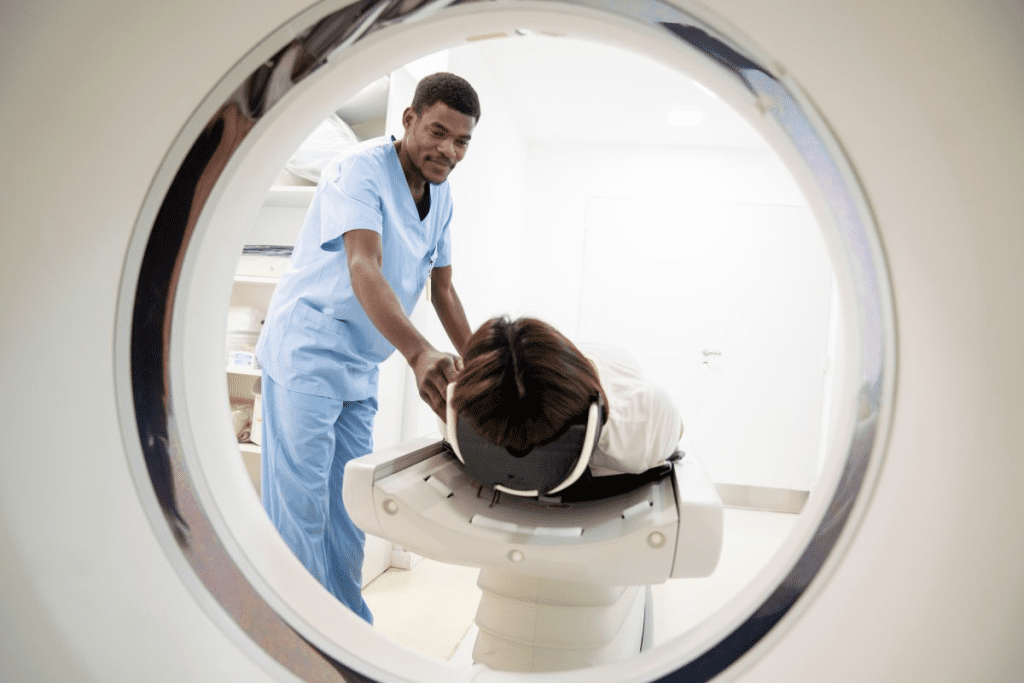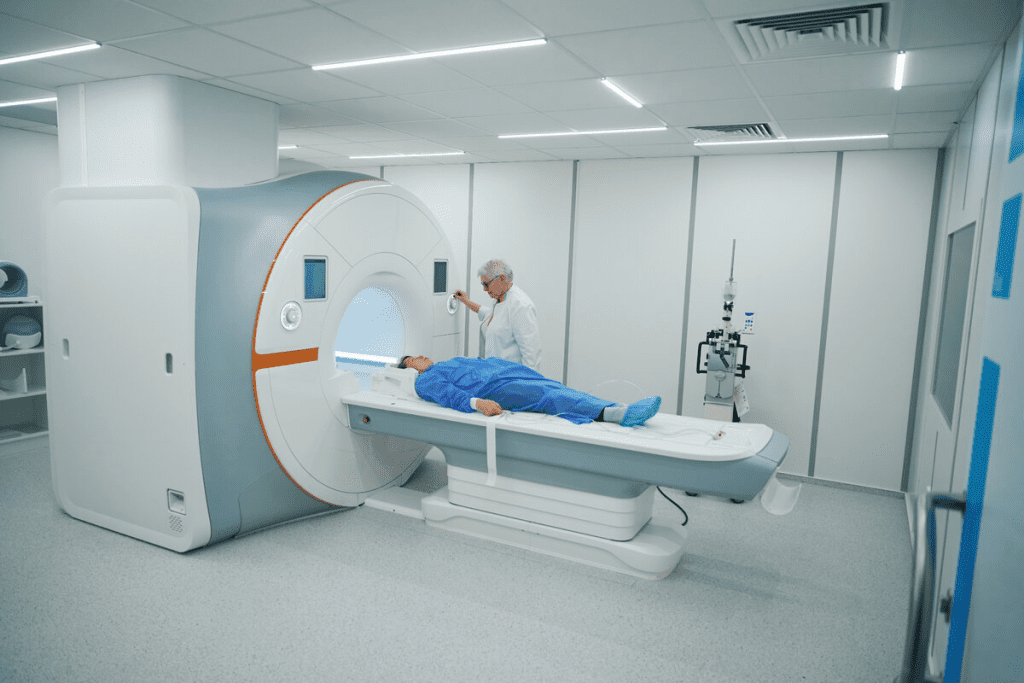Last Updated on November 25, 2025 by

Urology MRI scans are key in diagnosing and managing urological issues. Many patients wonder how long these scans last. Knowing what to expect can ease their anxiety.
A prostate MRI, a common urology MRI, usually takes 30 to 45 minutes. This includes getting ready, the scan itself, and sometimes watching over you after. The exact time can change based on the scan type and if contrast agents are used.
MRI has changed urology, letting doctors see the urinary system clearly. We’ll look at what urology MRI exams are, their types, and how safe they are.
A urology MRI is a test that doesn’t hurt. It uses strong magnets and radio waves to show the urinary system. This includes the kidneys, bladder, and prostate. It’s safer than X-rays or CT scans because it doesn’t use harmful radiation.

There are many MRI scans for urology, each for different needs. Here are a few:
One big plus of MRI is that it’s safe, with no radiation. Does MRI have radiation? No, it doesn’t. This makes it great for people who need many tests or are worried about radiation.
Knowing how safe and useful MRI exams are is key. They offer great insights for both patients and doctors in urology.
The prostate MRI procedure has several steps. Knowing the timeline can help reduce anxiety. We’ll walk you through from start to finish, including preparation, scanning, and after the scan.

A prostate MRI scan usually lasts 30 to 45 minutes. Some doctors say it can vary. This depends on the scan’s complexity and the technology used.
Patients must stay very quiet during the scan. This ensures the images are clear. Our team works hard to make you comfortable.
Research shows prostate MRI scan times can differ. While most scans last 30 to 45 minutes, some may take longer. This is due to specific needs or extra imaging.
Using contrast agents or certain imaging methods can add time. Our facility uses the latest technology. This helps keep the scan time down while ensuring quality images.
The total time for a prostate MRI includes preparation, scanning, and sometimes waiting. Getting ready for the scan involves removing metal items and making sure you’re comfortable and informed.
The actual scan takes 30 to 45 minutes. After, some patients may wait a bit. This is to check for any reactions to contrast agents.
In total, you should plan to spend about 1 to 2 hours at our facility. We aim to make your experience as smooth and stress-free as possible.
The time it takes for a urology MRI can change based on several factors. The use of contrast agents and the imaging protocol can greatly affect the time. We will look into these factors to help patients know what to expect.
Contrast agents are a big factor in MRI time. They make MRI images clearer, which is important for some exams. Using them means more time for the agent to be given and for images to be taken. This can make the scan longer.
The MRI protocol used is also key. Protocols vary based on what’s being examined. For example, a prostate MRI might need special sequences. The more complex the sequences, the longer the scan.
Things like claustrophobia or the need for sedation can also affect time. Patients with claustrophobia or needing sedation might take longer. Our team is ready to help make sure patients are comfortable.
The MRI machine’s type and age also matter. Newer machines often scan faster. Advances in technology can make exams quicker without losing image quality.
Knowing these factors helps plan MRI exams better. By thinking about contrast agents, protocols, patient needs, and machine tech, we can make MRI exams better for everyone.
Getting ready for a urology MRI is very important. It helps get accurate results and makes the scan go faster. Doing it right means better images and less time spent at the facility.
Before the scan, you’ll get special instructions. You might need to fast or avoid certain foods and drinks. Also, some medicines or supplements could affect the results, so it’s best to avoid them.
Following these instructions is key to getting great images. You’ll also need to remove metal items like jewelry and glasses. This is because metal can mess with the MRI machine.
Being on time for your MRI is very important. Try to arrive 30 minutes early. This gives you time to fill out forms, change into a gown, and get ready for the scan.
Arriving early helps avoid delays and makes the check-in smoother.
If you’ve had a prostate biopsy, wait at least four weeks before your MRI. This is because MRI results are more accurate after this time. Waiting helps ensure the scan is as precise as possible.
“Performing MRI too soon after a biopsy can compromise the accuracy of the results. Waiting for at least four weeks post-biopsy significantly improves diagnostic accuracy.” “ A radiologist
How well you prepare affects the MRI’s total time. Being ready can make the whole process quicker. This means having your documents in order, following instructions, and arriving on time.
Good preparation is essential for a quick and smooth MRI. By following the guidelines, you help make your MRI scan efficient and effective.
Getting a prostate MRI might seem scary, but knowing what to expect can help. We’ll walk you through each step, from getting ready to the scan itself and after.
When you get to the MRI center, our staff will help you get ready. You’ll lie on a table that moves into the MRI machine. They’ll make sure you’re in the right spot for the best pictures of your prostate.
They might put a coil near your prostate to get better images.
Once you’re set, the table will slide into the scanner. You’ll hear loud noises, which is normal. Wearing earplugs or headphones can help block out the sound.
It’s important to stay very quiet and not move to get clear pictures. The scan usually takes 30 to 45 minutes, depending on the details and whether contrast agents are used.
You can talk to our technicians through an intercom during the scan. They’ll tell you when to hold your breath or move a bit. If you’re uncomfortable or need help, just let them know.
Our team wants to make sure you’re comfortable.
To stay comfortable, wear loose clothes and avoid anything that might bother you during the scan. If you’re scared of tight spaces, we can help or use a wide-bore MRI machine. Our staff is trained to help you relax and enjoy the experience.
Learning about the prostate MRI process can help you feel less anxious. Our team is here to support and care for you every step of the way.
Getting your prostate MRI results right is key to planning your treatment. After a prostate MRI, doctors look at the images to find any problems or issues.
The Prostate Imaging Reporting and Data System (PI-RADS) helps doctors guess if you might have serious prostate cancer. The score goes from 1 to 5. A higher score means they think there’s a bigger chance of cancer.
Many things can change how accurate your MRI results are. These include the MRI’s quality, the doctor’s skill, and if contrast agents were used. Good images and skilled doctors are very important for correct diagnoses.
How long it takes to get your MRI results can vary. It depends on the radiology team’s workload and how complex your case is. Usually, you’ll get your results in a few days to a week after the scan.
Sometimes, you might need more tests to understand your MRI better. Your doctor will decide this based on your PI-RADS score, medical history, and other factors.
Understanding your MRI results is a big step in taking care of your prostate. By talking with your healthcare team, you can make smart choices about your health.
We’ve given a detailed look at the urology MRI procedure, focusing on how long it takes and what patients go through. We found that the average scan time is 30-45 minutes. But the total time can change because of things like contrast agents and certain imaging methods.
It’s important for patients to know what happens before, during, and after the scan. This knowledge helps them understand their results better. Being informed makes it easier for patients to make good choices about their health.
To wrap it up, a prostate MRI is a key tool for doctors to diagnose issues. We hope this summary has helped you understand what to expect during your MRI. It’s a big step in your health journey.
A prostate MRI usually lasts between 30 and 45 minutes. This includes getting ready and the actual scan.
No, MRI scans don’t use radiation. This makes them a safe way to get medical images.
The PI-RADS system rates the chance of prostate cancer. Scores range from 1 to 5.
MRI’s accuracy in finding prostate cancer depends on a few things. These include the scan’s quality and the radiologist’s skill.
Urological MRI scans include prostate, kidney, and urinary tract scans.
To prepare, follow dietary rules and arrive early. Also, listen to your healthcare provider’s pre-scan instructions.
No, getting your MRI results takes time. You’ll usually get them a few days to a week after the scan.
A few things can change how long a urology MRI takes. These include contrast use, imaging protocols, and patient factors like claustrophobia.
A prostate MRI starts with the patient lying on the MRI table. They then move into the MRI machine for the scan.
A prostate MRI can use contrast or not. It depends on what the doctor needs for the scan.
Villeirs, G., De Visschere, P., & others. (2019). Multiparametric MRI of the prostate: From scientific triumph to daily practice. Journal of the Belgian Society of Radiology, 103(1), Article 75. https://doi.org/10.5334/jbsr.1929
Subscribe to our e-newsletter to stay informed about the latest innovations in the world of health and exclusive offers!